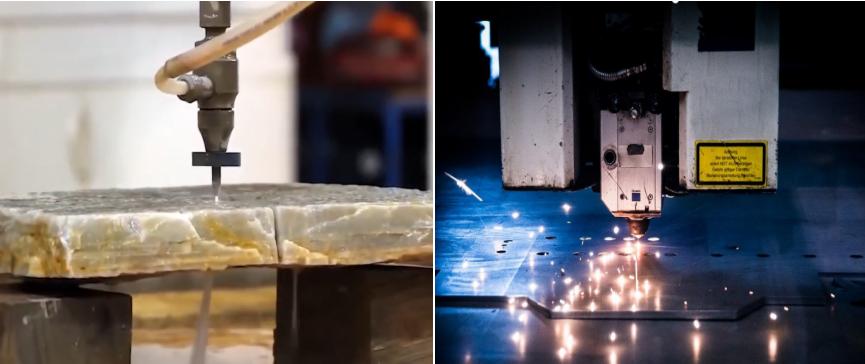Jan 29 , 2023
If it is said to cut the material, there are many ways to achieve it, such as sawing, gas cutting, etc., that can realize the cutting of various materials. But none of these cutting methods were perfect, so waterjet cutting and laser cutting were invented, which are widely used today and have proven to be the most effective cutting solutions in the industry.
First, let's take a look at the differences and similarities between the two cutting methods of waterjet and laser.
A water jet, which uses water as a knife, pressurizes the water in the container to ultra-high pressure, and then injects high-pressure water flow through a very small nozzle, so as to realize the cutting of materials; in order to increase the cutting capacity, of some pomegranate sand, Abrasives such as diamond are added to water, which is a widely used cutting method now.

Laser cutting is to produce a high-power laser beam through a machine, and then irradiate the material to be cut. The high temperature generated by the laser will melt or vaporize the irradiated material, thereby realizing the cutting of the material. What's more, the laser cutting machine application is in a wide range.
Waterjet has almost no restrictions on the materials that can be cut. Waterjet cutting does not allow the material to generate heat, thereby avoiding the phenomenon of melting, warping, bending, burning, etc. of the material being cut; common types of materials for waterjet cutting Including plastic, rubber, stone, ceramic tile, stainless steel, and other metals.
lasers are capable of cutting a wider range of metals, including stainless steel and carbon steel, as well as aluminium and many alloys, some lasers can cut through non-conductive materials such as wood, glass or plastic, but the heat generated by the laser can cut through some Metal products have an impact.
Waterjet: There is no limit to the thickness of the material to be cut by the waterjet. It mainly depends on the pressure of the jetted water. The greater the pressure, the thicker the material can be cut.
Laser: In a general mechanical workshop, most lasers can cut metals of about 2 cm, but the thickness of the cutting material also varies according to the metal. The melting point and thermal conductivity of the metal will affect the thickness of the laser cutting; the advantages of the sheet and tube laser cutting machine The advantage is that it can cut thinner materials at much higher speeds than a waterjet.
Waterjet: The incision width of the waterjet is about 0.7 mm, the cutting surface is very thin, and in some cases almost reaches the quality of the machine, but there will be some errors from the top to the bottom of the slit, and the thicker the material, the error will be bigger.
Laser: The cutting error of 6000w laser is much smaller than that of waterjet. When cutting tight geometric shapes on small parts or when parts need to be nested closely together, laser cutting can be used, and laser cutting can make the surface of cutting profiles Much cleaner and smoother, but also leaves some streaks with thickness or speed.
Waterjet: Waterjet cutting is a precise and versatile cutting method that can cut a wide variety of materials and thicknesses. Although the speed of waterjet is not as fast as laser in some materials, it can provide high cutting quality. No heat is generated to affect the material.
Laser: Laser cutting is very fast and accurate, but it depends on the material and thickness. In general, the speed and accuracy of the laser are very high. For thicker materials or materials that will be affected by heat, it is best to find another cutting method.
With the emergence of new materials such as carbon fiber reinforced polymers, and ceramic matrix composites, the machining of these new materials has become a problem.
Both waterjet and laser cutting have some defects. In order to meet this challenge, waterjet laser cutting technology has been developed to process such advanced composite materials.
Waterjet laser cutting is a hybrid process, also known as laser microjet, that combines a laser with a "thin" water jet that is precisely guided in a manner similar to conventional fiber optics. The laser beam realizes the cutting, and the water jet continuously cools the cutting area and effectively removes the debris generated during cutting.
This technology was first applied to the cutting of semiconductor wafers. As the technology matures, it is gradually extended to medical equipment, clock processing, gas and jet engine turbine blades, machining of semiconductor equipment, and material cutting in the manufacturing process of superhard tools. .
After the laser is focused, it will form a laser beam. When it passes through the pressurized water chamber, it will push the water forward and focus into the nozzle. Finally, the laser beam will be ejected from the nozzle together with the water flow.
There is no abrasive in the water flow, so the cutting mainly depends on the laser. The function of the water is to use the water column to guide the laser to not disperse, gather the laser energy to cut faster, and also have the effect of cooling down and removing debris.
In the distance from the nozzle to the cutting workpiece, the laser beam will not disperse, but will continue to reflect and move forward in the water column. In principle, it is similar to optical fiber transmission. The laser beam can be guided at a distance of up to 10cm, so as to achieve neat cutting. Slits without refocusing or distance control.